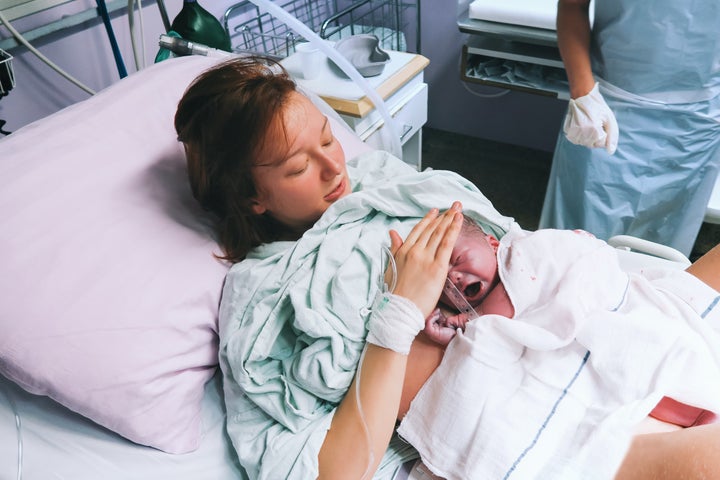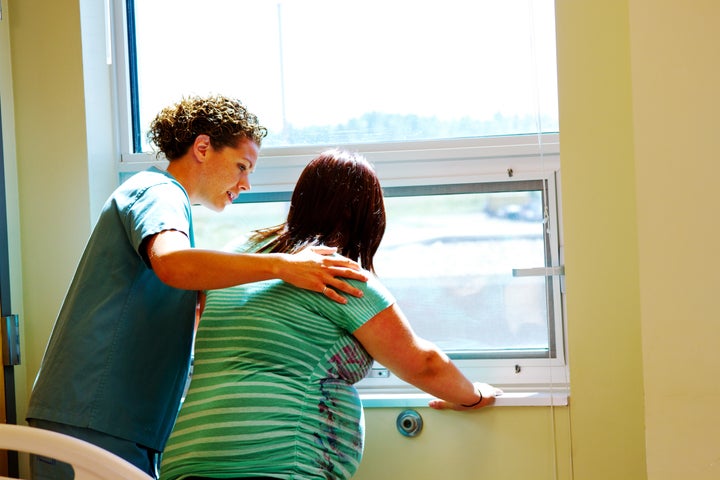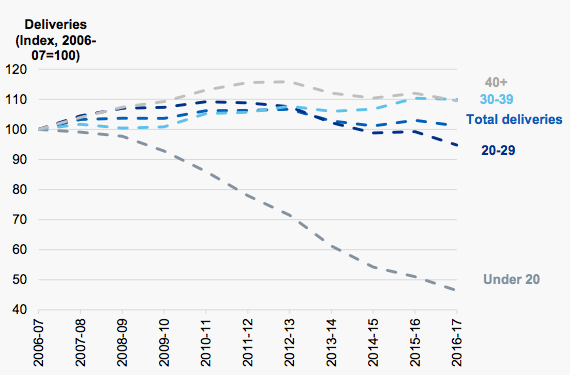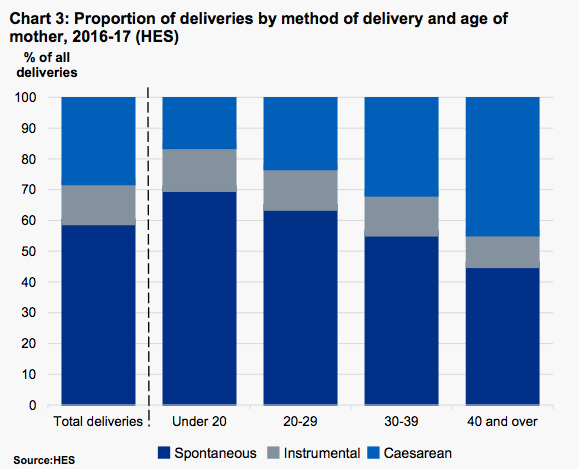New NHS figures reveal a fascinating insight into how women give birth in England.
Just over half (55.1%) of the pregnant women who gave birth in NHS hospitals in 2016-17 went into labour spontaneously, 29.4% were induced and 15.5% underwent a caesarean before the onset of labour, figures from NHS Digital show.

The ‘NHS Maternity Statistics 2016-17’ report recorded a total of 636,000 deliveries in NHS hospitals during 2016-17, a decrease of 1.8% from the previous year.
In 60% of deliveries women made use of anaesthetic or analgesics (painkillers).
The most common delivery complications were perineal laceration (tearing), which occurred in 41.9% of deliveries, and fetal stress (distress), which occurred in 25.4% of deliveries.

National Institute for Health and Care Excellence (NICE) guidelines stressing the importance of skin-to-skin contact at birth to promote the initiation of breastfeeding and protect against the negative effects of mother-baby separation have widely been followed, as 80% of women who submitted data to the Maternity Services Data Set with babies born at 37 weeks gestation or more had skin-to-skin contact within one hour of birth.
Also, 74% of babies received breast milk (maternal or donor) for their first feed.

The number of spontaneous labours has decreased over the past 10 years from 68.7% in 2006-2007 to 55.1% in 2016-17.
During the same period there has been an increase in the proportion of planned caesareans before the onset of labour, from 11% to 15.5%, and of induced labour, from 20.3% to 29.4%.
Mr Edward Morris, spokesperson for the Royal College of Obstetricians and Gynaecologists (RCOG), believes there are a number of factors that account for the decrease in spontaneous labour.
“These figures reflect the increasing number of complex births due to rising maternal age and obesity, together with more women with pre-existing medical conditions having babies,” he told HuffPost UK.
“Together these factors increase the risk of miscarriage, stillbirth and a more complicated labour, resulting in medical interventions such as the need for planned or emergency caesarean sections, instrumental vaginal deliveries and induced labours.”
Abi Wood, head of campaigns and communications at NCT, said women should have their decisions about whether to be induced respected.
“Women and their families’ needs should be at the core of all maternity services,” she said.
“This promotes better outcomes for mums and babies and helps families feel informed and supported throughout pregnancy and birth.
“While it can feel frustrating to go past a ‘due date’, this is only an estimated time. Pregnant women can always talk to their midwives about options including the risks and benefits to them and their babies of inductions, caesareans and waiting longer for spontaneous labour .
“NICE guidance makes it clear that women’s decisions about whether or not to have an induction should be respected, and that the timing should take into account their preferences and circumstances.”

The proportion of women giving birth aged 30 years or over has increased, with the 40 and over age group showing the largest percentage increase since 2006-7, up 9.5% to 24,386 deliveries in 2016-17.
The proportion of women giving birth below 30 years of age experienced a decline.
The largest change can be seen in the number of teenagers giving birth, which has more than halved over the period, decreasing to 20,021 deliveries in 2016-17.

The data also looked into the difference in the methods of delivery - spontaneous, instrumental (involving forceps, ventouse or breech extraction) or caesarean - for each age group.
The proportion of caesarean deliveries increases with age and accounts for 44.1% of deliveries to women aged 40 and over.
Amongst this age group, 23.5% of these caesareans were elective procedures and 20.1% were emergencies.

The number of women seeking pain relief during labour has declined over the last decade. 68.6% of women had an anaesthetic or analgesic administered before or during delivery in 2006-07 compared to 60% in 2016-17.
The report states that this decline “may be explained by NICE guidelines on epidurals which states that women should be advised of the advantages and disadvantages of epidurals including ‘a longer second stage of labour and an increased chance of vaginal instrumental birth’”.